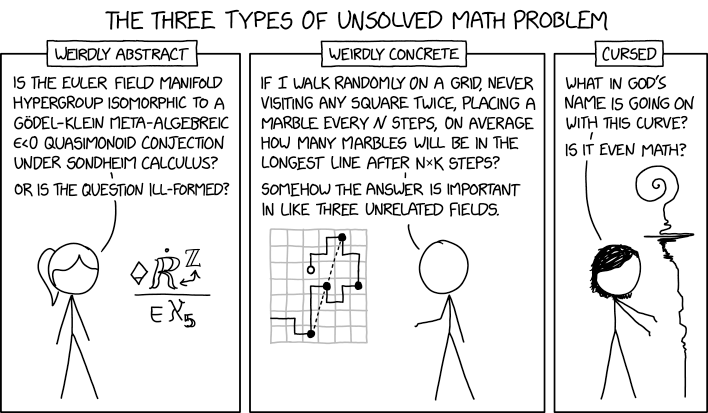
Title text: After decades of studying the curve and the procedure that generates it, the consensus explanation is "it's just like that."
She should pick up the curve and wield it like a staff.
Nerd-sniped?The Snide Sniper wrote: ↑Sun Oct 17, 2021 1:03 am I kinda want to know the answer to the second one.
ratammer wrote: ↑ Hoping to find something quotable on this new forum!
ratammer wrote: ↑In both cases the quote is "I'm being quoted too much!"
what do u think i spent my friday and saturday onsomitomi wrote: ↑Sun Oct 17, 2021 7:16 pmNerd-sniped?The Snide Sniper wrote: ↑Sun Oct 17, 2021 1:03 am I kinda want to know the answer to the second one.
ok so ive figured some stuff out, and further ive reasoned out that there's some ways to basically do the nonintersecting random walk, without just having to spam random walks for a long time, but with the same result. (dm here or on discord again for more info)pulsar512b wrote: ↑Mon Oct 18, 2021 2:37 amwhat do u think i spent my friday and saturday onsomitomi wrote: ↑Sun Oct 17, 2021 7:16 pmNerd-sniped?The Snide Sniper wrote: ↑Sun Oct 17, 2021 1:03 am I kinda want to know the answer to the second one.
ok in all seriousness, i havent gotten to figuring that out, but i have got a program that does some non-intersecting random walk stuff and I HAVE SOME OPINIONS OK
WHAT DOES "NONINTERSECTING RANDOM WALK MEAN" DOES IT MEAN NEVER INTERSECTING, or JUST NOT LIKE, IMMEDIATELY RUNNING INTO ITSELF OR WHAT??????
because, like if it never intersects if N and K are sufficiently large that like N*K is like in the hundreds, then you have to do quite a few runs with just a random walk to see one that keeps going for long enough
anyway code https://github.com/pulsie/non-intersecting-random-walk do whatever you want, there's no documentation but just dm me here/discord and i'll tell ya
i also got fun graphs, but that's beside the point, more importantly, i've got to the point where i think the hardest part of figuring out how to sim the original problem is finding colinearity tbh